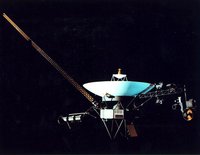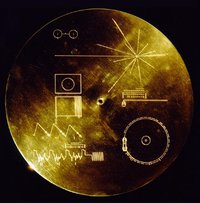Voyager program
|
|
Titan_3E_Centaur_with_Voyager_2.jpg
The Voyager program consisted of a pair of unmanned scientific probes, Voyager 1 and Voyager 2, launched in 1977. They were sent to study Jupiter and Saturn, using an advantageous planetary alignment of the late 1970s. However, the mission planners always had in the back of their minds a continued mission, and Voyager 2 also examined Uranus and Neptune. They were originally conceived as part of the Mariner program, being Mariner 11 and Mariner 12 respectively. The original program name was Mariner Jupiter-Saturn. It was later given the more appealing and romantic name "Voyager".
Voyager was actually a scaled back version of the Grand Tour program of the late 1960's and early 1970's to send a pair of probes to fly by all the outer planets (scaled back because of budget cuts). In the end, they fulfilled all the Grand Tour flyby objectives save Pluto despite not being officially designed for such a long duration mission.
Both missions revealed large amounts of information about the gas giants of the solar system. In addition, the spacecraft have been used to place limits on the existence of a hypothetical post-Plutonian Planet X.
In the 1990's Voyager 1 overtook the slower travelling Pioneer 10 to become the most distant man made artifact in space - a record it will keep for at least several more decades (and since they are traveling in opposite directions, Voyager 1 and Pioneer 10 are also the most widely separated man made objects).
Voyager_1_entering_heliosheath_region.jpg
Periodic contact has been maintained with both probes to monitor conditions in the outer expanses of the solar system. The crafts' radioactive power sources are still producing electrical energy, fuelling hopes of locating our solar system's heliopause. In late 2003, Voyager 1 began sending data that may indicate it has crossed this barrier, but interpretations of this data are in dispute.
Due to budget restrictions, it seems the probes may be deactivated and abandoned [1] (http://news.bbc.co.uk/1/hi/sci/tech/4338245.stm) in October 2005 along with other spacecraft such as Ulysses.
These probes were built at JPL funded by NASA. Attached to each of them is a copy of the Voyager Golden Record.
| Contents |
Voyager spacecraft design and instrumentation
The identical Voyager spacecraft are three-axis stabilized systems that use celestial or gyro referenced attitude control to maintain pointing of the High Gain Antennas toward Earth. The prime mission science payload consisted of 10 instruments (11 investigations including radio science). Only five investigator teams are still supported, though data is collected for two additional instruments.
The Flight Data Subsystem (FDS) and a single eight-track digital tape recorder (DTR) provide the data handling functions. The FDS configures each instrument and controls instrument operations. It also collects engineering and science data and formats the data for transmission. The DTR is used to record high-rate Plasma Wave Subsystem (PWS) data. Data is played back every six months.
The Imaging Science Subsystem, made up of a wide angle and a narrow angle camera, is a modified version of the slow scan vidicon camera designs that were used in the earlier Mariner flights. The Imaging Science Subsystem Narrow Angle Camera consists of two television-type cameras, each with 8 filters in a commandable Filter Wheel mounted in front of the vidicons. One has a low resolution 200 mm wide-angle lens with an aperture of f/3, while the other uses a higher resolution 1500 mm narrow-angle f/8.5 lens.
Unlike the other onboard instruments, operation of the cameras is not autonomous, but is controlled by an imaging parameter table residing in one of the spacecraft computers, the Flight Data Subsystem (FDS).
The computer command subsystem (CCS) provides sequencing and control functions. The CCS contains fixed routines such as command decoding and fault detection and corrective routines, antenna pointing information, and spacecraft sequencing information.
The Attitude and Articulation Control Subsystem (AACS) controls the spacecraft orientation, maintains the pointing of the High Gain Antenna towards Earth, controls attitude maneuvers, and positions the scan platform.
Uplink communications is via S band (16-bit/s command rate) while an X band transmitter provides downlink telemetry at 160 bit/s normally and 1.4 kbit/s for playback of high-rate plasma wave data. All data is transmitted from and received at the spacecraft via the 3.7-meter high-gain antenna (HGA).
Electrical power is supplied by three radioisotope thermoelectric generators (RTGs). The current power levels are about 315 W for each spacecraft. As the electrical power decreases, power loads on the spacecraft must be deactivated in order to avoid exceeding its remaining power supply. As loads are turned off, some spacecraft capabilities are eliminated.
To date, the entire Voyager 2 and Voyager 1 scan platform, including all of the platform instruments, has been powered down. The ultraviolet spectrometer (UVS)[2] (http://voyager.jpl.nasa.gov/spacecraft/instruments_uvs.html) on Voyager 1 was on until 2003, when it too was deactivated. Gyro operations will end in 2010 for Voyager 2 and 2011 for Voyager 1. Gyro operations are used to rotate the probe 360 degrees 6 times a year. This is used to measure the magnetic field of the spacecraft, which is then subtracted from the magnetometer science data.
The two Voyager spacecraft continue to operate, with some loss in subsystem redundancy, but retain the capability of returning science data from a full complement of VIM science instruments. Both spacecraft also have adequate electrical power and attitude control propellant to continue operating until around 2020 when the available electrical power will no longer support science instrument operation. At this time science data return and spacecraft operations will cease.
The radioisotope thermoelectric generators are powered by plutonium, and provided approximately 470 W of 30-volt DC when the spacecraft was launched. Plutonium-238 decays with a radioactive half-life of approximately 85 years, so RTGs using it lose a factor of <math>1 - \sqrt[85]{0.5}<math> or ca. 0.81% of the power per year. 23 years after launch, such an RTG would produce only 470 W × 0.991923 ~= 390 W — or roughly 83% — of the initial power. However, the bi-metallic thermocouples used to convert thermal energy into electrical energy degrade as well; at the beginning of 2001, the power generated by Voyager 1 had dropped to 315 W and to 319 W for Voyager 2, so the thermocouples work at about 80%. Both of these power levels represent better performance than the pre-launch predictions, which included a conservative degradation model for the thermocouples.
Golden Record
Voyager 1 carries with it a golden record (Voyager Golden Record) that contains pictures and sounds of Earth, along with symbolic directions for playing the record and data detailing the location of Earth. The record is intended as a combination time capsule and interstellar message to any civilization, alien or far-future human, that recovers Voyager 1. The contents of this record were selected by a committee chaired by Carl Sagan.
See Also
- Voyager 1 for mission details
- Voyager 2 for mission details
- Star Trek: The Motion Picture a fictional account of an alien intelligence finding the fictional Voyager 6 (aka V'ger).
- Star Trek: Voyager a T.V. series about a StarFleet starship named U.S.S. Voyager NCC-74656 stranded at the other side of the galaxy.
External links
- NASA Voyager website (http://voyager.jpl.nasa.gov) - Main source of information.
- Voyager Spacecraft Lifetime (http://voyager.jpl.nasa.gov/spacecraft/spacecraftlife.html)
- Spacecraft Escaping the Solar System (http://www.heavens-above.com/solar-escape.asp) - current positions and diagrams
- Voyager 1 and 2 atlas of six Saturnian satellites (PDF format) 1984 (http://ntrs.nasa.gov/archive/nasa/casi.ntrs.nasa.gov/19840027171_1984027171.pdf)
- Mission state (http://voyager.jpl.nasa.gov/mission/weekly-reports/)de:Voyager 1
fr:Sondes Voyager it:Programma Voyager nl:Voyagerprogramma ja:ボイジャー ru:Вояджер fi:Voyager
Categories: Jupiter | Saturn | Uranus | Neptune | Spacecraft | Space exploration | NASA programs


